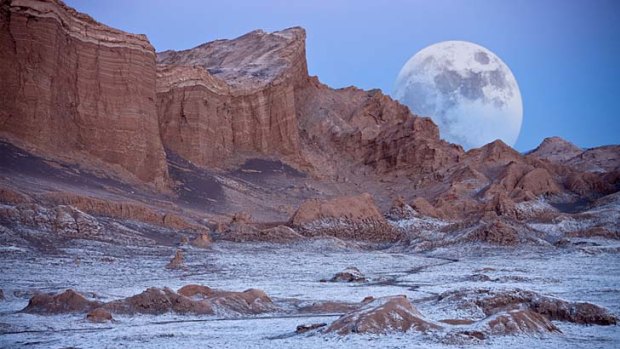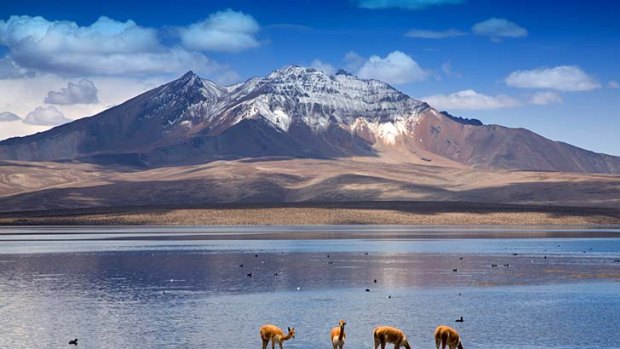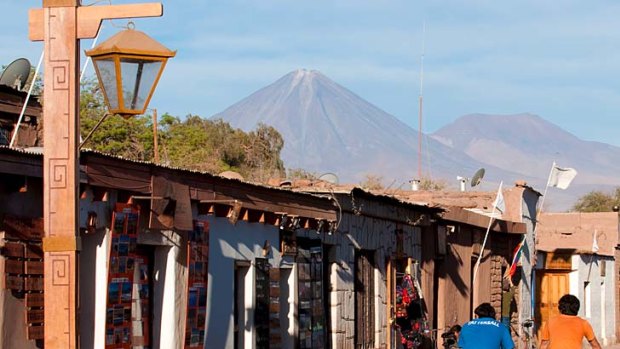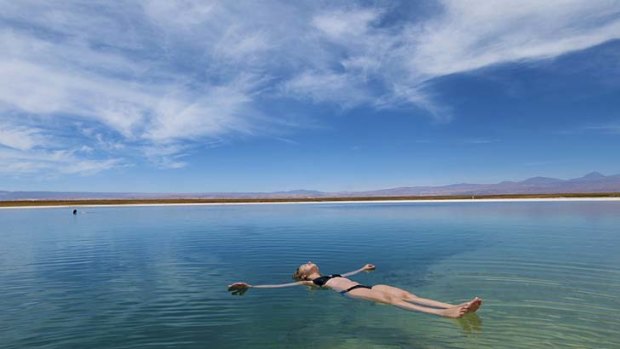
High and dry ... Valle de la Luna, Atacama Desert.Credit: Getty Images
Ben Groundwater marvels at the beautiful desolation of Chile's Atacama Desert.
Max surveys the scene with eyes open wide, shaking his head in wonder. "If you painted a picture," he says, somewhat grandiosely, "no one would believe you."
Max loves these poetic proclamations, but in this case he's spot on. No one would believe you.

Vicunas graze near one of the Atacama's lakes.Credit: Alamy
The landscape is like nowhere else on earth, nothing you could dream up. The barren lake bed is a sea of jagged edges, ripples of salt crystals frozen in place. From its edge the slate-grey desert stretches far into the distance, eventually wrapping around the base of the snow-capped volcanoes on the horizon.
If this really were a painting it would be a modernist type of thing, with large blocks of colour slapped across the canvas: the white of the salt beneath our feet; the grey of the rocky desert; the deep, rich blue of a cloudless sky. There are no other features to include. There's nothing else here.
This is the Atacama Desert in northern Chile, a place of extremes. It's so desolate it's incredible. Rainfall averages one millimetre a year. Apart from the few oases that dot the area, it's completely barren, a lunar landscape of sharp rocks and stubborn cactuses.

Caracoles Street in the town of San Pedro de Atacama.Credit: Alamy
If you wanted the world's easiest job as a weatherman, you'd head straight here. What will the weather be like tomorrow? Sunny. And the next day? Sunny. What about the long-range forecast? Sunny.
In such a harsh environment, 2500 metres above sea level in a place where the temperature regularly swings 40 degrees within 12 hours, it seems impossible to think there might be life here, that anything would be hardy enough to survive. And yet with a bit of exploration you soon realise that life doesn't just exist, it thrives.
The first sign of that is right here at the salt lake that stretches across the Atacama floor. While Max, a fellow traveller, is gazing off at the distant majesty of the Licancabur volcano, the rest of us are concentrating on the unlikely flock of flamingoes standing long-legged in the shallow waters in front of us.

A woman floats in the salty lagoon.Credit: Getty Images
Flamingoes? Out here? Their pink feathers seem as incongruous as a neon sign, but the birds have good reason to have made the journey, as they get to feast on the tiny shrimp that somehow live in these salty, stale waters.
The flamingoes are just one of the attractions that bring travellers to this most implausible tourist destination. Who thought to bring people here? Plenty of holidaymakers picture sun and sand on their trip away, but not like this.
Your average beach resort, however, doesn't give you the chance to see volcanic valleys that look like they've been sent from the moon. It doesn't let you see huge geysers high up in the Andes, or float suspended in the highly salted waters of a desert lake. It doesn't give you the chance to experience life in a place that has no right to support it.
San Pedro de Atacama is the base from which most people explore the desert, a small town set in an oasis with the perfectly triangular Licancabur towering in the background. Tierra Atacama, a hotel on the outskirts of town, feels like an oasis in itself, with large airconditioned rooms and a huge common area with views across to that spectacular volcano.
The hotel runs its own excursions out to the desert's main attractions, all of which you're given a run-through at check-in. The trips are timed to get guests out and about in the mornings and evenings, leaving the hottest part of the day free to soak up the aircon and another three-course lunch.
The salt lake is one of the more popular destinations, with several excursions running to different sections. The first trip, the one Max is on, is designed to view the flamingoes, while another gives you a blast of hot desert air on mountain bikes.
It's then you realise the strange tricks the Atacama can play. Distance is almost impossible to judge up here in the desert air - there's so little moisture that light travels further than usual, making far-off landmarks appear easily within reach.
What looks like a small group of huts just up on the hillside turns out to be a town of 5000 people that's a good three-hour drive away.
But it's worse when you're cycling. "The lake is just a little bit past that tree up there," Jasu, our mountain-biking guide, says, pointing at a lonely shrub just up the road. No worries, you think, we'll be there in no time. But the tree doesn't get closer. You pedal and pedal, but never seem to arrive. Bizarre. Turns out it's miles away.
This part of the lake, however, is worth the long ride. There are no flamingoes but there is still life, this time in the form of tourists enjoying one of the freaks of Atacaman nature: a pool so deep no one has been to the bottom, and so salty there'd be no point trying anyway.
It's like the Dead Sea, with people floating easily in it, three-quarters of their bodies out of the icy cold water. It burns your cracked lips it's so salty, but the feeling of being suspended in a desert pool under a big blue sky is one you're unlikely to replicate any time soon.
To the other side of San Pedro lie the twin valleys, Valle de la Muerte (Death Valley) and Valle de la Luna (Moon Valley). Both are volcanic, formed by a mighty cleaving of the earth millions of years ago, leaving these jagged scars running through the desert floor.
Death Valley is spectacular, although not as sinister as it sounds. It was originally dubbed Valle de la Marte - the Valley of Mars - by locals, but was misheard by a visiting priest as "Valle de la Muerte". Somehow, the newcomer's name stuck.
For modern-day visitors a walk through here is a step into a hostile, strange land, where rocks jut out of the earth like they were thrown there in a fury, and cactuses stand determined against stacked odds. It's intimidating but spectacular.
The jewel in the Atacaman crown, however, is the trip to El Tatio, a group of geysers about 4400 metres above sea level on a plateau that's outside the desert proper. It's still barren, of course, but with a light-green moss covering the otherwise lunar landscape. The volcanoes loom ever-present, some with pillars of smoke gushing out of them.
Breath comes short up here - you don't want to try to move too fast. There's still life, though, incredibly. Vicunas, the camel-like creatures of the Andes, roam the plateau, drinking water from the springs and feeding on the moss.
It's another spectacular sight: volcanoes in the distance, herds of vicunas on the plain and all around the bubbling geysers shooting huge clouds of steam high into the air like a sea of tiny tornadoes.
Max is right again: if you painted a picture, no one would believe you.
The writer travelled as a guest of the Classic Safari Company.
Three other things to do in San Pedro de Atacama
1 Hike the Gautin-Gatchi Trail Connecting the two villages of Gautin and Gatchi is a narrow canyon that follows the course of a river. It's easy enough to hike along the banks, clambering over rocks and trying to avoid the spiky sentinels - giant cactuses - that cling to the canyon walls.
2 Drink a Pisco Sour As unlikely as it sounds, San Pedro can be something of a party town, where travellers reunite after a day of exploring to swap stories over a few drinks. You can't leave Chile without trying a Pisco Sour, the local spirit mixed with sugar and lime juice. Just, go easy.
3 Go sandboarding You're in the desert, which means sand, right? There actually aren't many large dunes in the Atacama, and most are protected, but there are a couple set aside for sandboarding. If you fancy sliding down a dune on a snowboard, the operators in San Pedro are hard to miss.
Trip notes
Getting there
LAN Airlines flies to the town of Calama in the Atacama, via Santiago. Transfers to San Pedro can be arranged through the hotel. 1800 558 129, lan.com.
Staying there
The Classic Safari Company offers four-night packages staying at the Tierra Atacama from $1715. The price includes accommodation, transfers, all meals and drinks, and all excursions with English-speaking guides. 1300 130 218, classicsafaricompany.com.au.
More information
Sign up for the Traveller Deals newsletter
Get exclusive travel deals delivered straight to your inbox. Sign up now.